Istrenyan Crisis: Difference between revisions
mNo edit summary |
|||
| (2 intermediate revisions by 2 users not shown) | |||
| Line 21: | Line 21: | ||
Istrenya was never under direct colonial rule from any Levantine or Sarpedonian nations, however mercantile influence had often relegated it to inconsistent economic growth and recurring bouts of recession and economic strife. Traditionally the maritime economy Istrenya enjoyed was primarily based on fishing, simple agriculture, and raw mineral and natural resource extraction, however with the expansion of modern Occidental corporations in the 19th and 20th centuries, these companies grew to inherit large amounts of influence over the Istrenyan government. Most prominent amongst these were corporations from Arcerion, located directly across from Istrenya across the [[Warrington Strait]] and [[Malentine Sea]]. Following the end of the [[Second Great War]] and the rise of decolonization amongst many smaller Indigenous nations and their colonies, Istrenya saw a rise of socialist and liberal movements aimed at toppling the existing Populist government under President A'kale Treo. | Istrenya was never under direct colonial rule from any Levantine or Sarpedonian nations, however mercantile influence had often relegated it to inconsistent economic growth and recurring bouts of recession and economic strife. Traditionally the maritime economy Istrenya enjoyed was primarily based on fishing, simple agriculture, and raw mineral and natural resource extraction, however with the expansion of modern Occidental corporations in the 19th and 20th centuries, these companies grew to inherit large amounts of influence over the Istrenyan government. Most prominent amongst these were corporations from Arcerion, located directly across from Istrenya across the [[Warrington Strait]] and [[Malentine Sea]]. Following the end of the [[Second Great War]] and the rise of decolonization amongst many smaller Indigenous nations and their colonies, Istrenya saw a rise of socialist and liberal movements aimed at toppling the existing Populist government under President A'kale Treo. | ||
Increased activity amongst Indigenous peoples promoting Indigenous Nationalism had spread from Varshan into South Crona, with similar movements occurring in Porlos and Kelekona. During the Second Great War, Indigenous nations reinforced their neutral positions by refusing to allow many warships and airplanes from Arcerion and other Allied nations from using their facilities. It was assessed that communist and syndicalist sympathizers, foreign fighters, and ideological radicals from other Indigenous nations moved to Istrenya anticipating a much larger conflict, however the limited political success in the 1958 Istrenyan Elections meant that there was a limited perceived legitimate political base for liberal and socialist thought, and the majority of the dissidents were native Istrenyans. | Increased activity amongst Indigenous peoples promoting Indigenous Nationalism had spread from Varshan into [[South Crona]], with similar movements occurring in Porlos and Kelekona. During the Second Great War, Indigenous nations reinforced their neutral positions by refusing to allow many warships and airplanes from Arcerion and other Allied nations from using their facilities. It was assessed that communist and syndicalist sympathizers, foreign fighters, and ideological radicals from other Indigenous nations moved to Istrenya anticipating a much larger conflict, however the limited political success in the 1958 Istrenyan Elections meant that there was a limited perceived legitimate political base for liberal and socialist thought, and the majority of the dissidents were native Istrenyans. | ||
== Crisis == | == Crisis == | ||
[[File:Istrenya Map.png|thumb|Map of Istrenya in 1959.]] | [[File:Istrenya Map.png|thumb|Map of Istrenya in 1959.]] | ||
| Line 49: | Line 49: | ||
==== Battle of Teremba ==== | ==== Battle of Teremba ==== | ||
Teremba was the key entryway to Lokokeja. Taking the town would allow for use of its wharf, rail junction between the coastal rail line and the mountain rail line, as well as access to Highway 1 - which ran the length of Istrenya to Karaba. The Norham Light Infantry encircled the town, and with fire support from the Craigfearn Fusiliers, managed to seize key objectives by June 17th, even with rebels in the city putting up stiff resistance. Within the town, parts of two Liberation Battalions, including the headquarters from the 1st Battalion, were destroyed due to combined mortar fire and the Combat Controller Section from the Arcer Air Force attached to 2nd Battalion, Norham Light Infantry coordinated with the Royal Arcerion Naval Air Service, coordinating air strikes and close air suppor to the infantry as the conducted the tough job of deliberate clearance in Teremba. | Teremba was the key entryway to Lokokeja. Taking the town would allow for use of its wharf, rail junction between the coastal rail line and the mountain rail line, as well as access to Highway 1 - which ran the length of Istrenya to Karaba. The Norham Light Infantry encircled the town, and with fire support from the Craigfearn Fusiliers, managed to seize key objectives by June 17th, even with rebels in the city putting up stiff resistance. Within the town, parts of two Liberation Battalions, including the headquarters from the 1st Battalion, were destroyed due to combined mortar fire and the Combat Controller Section from the Arcer Air Force attached to 2nd Battalion, Norham Light Infantry coordinated with the Royal Arcerion Naval Air Service, coordinating air strikes and close air suppor to the infantry as the conducted the tough job of deliberate clearance in Teremba. | ||
Despite a successful seizure of the town, and the now limited ability to Liberation forces to defend Lokokeja, there was a significant amount of damage to the civilian infrastructure, including the local electrical stations which had been destroyed by Arcer mortar fire. Then commander of the Norham Light Infantry, Lieutenant-Colonel Iain Gonnegal remarked on the performance of the Istrenyan National Guard, "..at times we spent more staff hours and effort try to deconflict the armed rabble that we had fighting alongside us, than fighting the communists in the town." | Despite a successful seizure of the town, and the now limited ability to Liberation forces to defend Lokokeja, there was a significant amount of damage to the civilian infrastructure, including the local electrical stations which had been destroyed by Arcer mortar fire. Then commander of the Norham Light Infantry, [[Iain Gonnegal|Lieutenant-Colonel Iain Gonnegal]] remarked on the performance of the Istrenyan National Guard, "..at times we spent more staff hours and effort try to deconflict the armed rabble that we had fighting alongside us, than fighting the communists in the town." | ||
[[File:Airborne drop 11 brigade.jpg|thumb|Members of 11 Para Brigade are inserted into Drop Zone 'Mike' near Mogtepeni, Istrenya during their 1960 air assault as part of Operation Insolent. ]] | [[File:Airborne drop 11 brigade.jpg|thumb|Members of 11 Para Brigade are inserted into Drop Zone 'Mike' near Mogtepeni, Istrenya during their 1960 air assault as part of Operation Insolent. ]] | ||
==== Battle at M'kelo Airport ==== | ==== Battle at M'kelo Airport ==== | ||
| Line 73: | Line 73: | ||
[[Category:Arcerion]] | [[Category:Arcerion]] | ||
Istrenya would continue to be a relatively poor economic and Indigenous nation in South Crona. Continued economic sanctions from Arcerion, relatively weak and unstable currency, as well as continued instability crippled its growth and development until the 1990s and Arcerion re-establishing a diplomatic presence with a consulate in Karaba. Arcerion's long term public opinion of the conflict was of a necessary police action to suppress communists that were a short ferry ride away from one of Arcerion's largest cities. Many regiments and squadrons in the Arcer Military still remember the conflict as the first major action after the Second Great War, with the Royal Moorden Regiment still celebrating July 23rd as the anniversary of the victory at M'kelo Airport. The Norham Light Infantry have named their main garrison in Arcerion the 'Teremba Barracks' after their engagement in Istrenya. In Istrenya, the conflict is more commonly remembered as a civil war, with Ma'kle Tytosh being one of the few individuals from that period still considered a national person of significance despite attempts by the Populist Government to destroy any national memory to prevent another uprising. | Istrenya would continue to be a relatively poor economic and Indigenous nation in South Crona. Continued economic sanctions from Arcerion, relatively weak and unstable currency, as well as continued instability crippled its growth and development until the 1990s and Arcerion re-establishing a diplomatic presence with a consulate in Karaba. Arcerion's long term public opinion of the conflict was of a necessary police action to suppress communists that were a short ferry ride away from one of Arcerion's largest cities. Many regiments and squadrons in the Arcer Military still remember the conflict as the first major action after the Second Great War, with the Royal Moorden Regiment still celebrating July 23rd as the anniversary of the victory at M'kelo Airport. The Norham Light Infantry have named their main garrison in Arcerion the 'Teremba Barracks' after their engagement in Istrenya. In Istrenya, the conflict is more commonly remembered as a civil war, with Ma'kle Tytosh being one of the few individuals from that period still considered a national person of significance despite attempts by the Populist Government to destroy any national memory to prevent another uprising. | ||
[[Category: 2022 Award winning pages]] | {{Template:Award winning article}} | ||
[[Category:2022 Award winning pages]] | |||
[[Category:IXWB]] | |||
[[Category: Crona]] | [[Category: Crona]] | ||
[[Category:IXWB]] | [[Category:IXWB]] | ||
[[Category:Arcer History]] | [[Category:Arcer History]] | ||
Latest revision as of 19:27, 6 December 2023
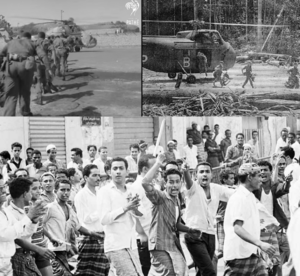 (Clockwise from top left) Members of 7 Rifle Brigade's Royal Moorden Regiment are extracted from Eastern Istrenya via helicopter; Arcer Army service members are dropped off near the Line of Contact (LOC) to conduct stabilisation operations; Indigenous protestors clash with Instrenyan National Policemen in the capitol during the 1959 Riots. | |
| Duration | 1959-1961; 3 years |
|---|---|
| Also known as | Istrenyan Crisis; First Istrenyan Civil War; Malentine Crisis |
| Type | Civil War |
| Cause | Communist and Popular Uprising |
| Participants | Arcerion Istrenya Various Insurgent/Political Groups |
| Outcome | Status quo; Communist Revolt suppressed, Indigenous Populist Government maintains power. |
The 1959 Istrenyan Civil Crisis, also known as the First Istrenyan Civil War or the Malentine Crisis was an armed rebellion by the National Instrenyan People's Front (NIPF) during the 20th century between 1959-1961 in the Southern Cronan nation of Istrenya.
Inspired by other socialist movements during the same decade, it began in April 1959 when a pair of Arcer diplomatic officials were assaulted by a mob, angered over recent increases in tariffs on Istrenyan agricultural exports to the Occidental nation. Heavy-handed responses by the national police and security forces led to more civilian and military deaths, as well as a continued escalation in the riots. Formal complaints by the Arcer government to the Istrenyan President's office resulted in a severe scalation in 1960, and with continued attacks on Occidentals, the Arcer government formally issued a notice to the Istrenyan government that it would conduct a military intervention to stabilise the situation.
By 1961, the crisis had stabilized, and the Arcer government was able to close its embassy and consulates in Istrenya, as well as withdraw the joint military task force it had deployed to the region. In the crisis' wake, the Istrenyan government managed to remain in power with assistance from the Office of Public Safety and National Security.
Background
Istrenya was never under direct colonial rule from any Levantine or Sarpedonian nations, however mercantile influence had often relegated it to inconsistent economic growth and recurring bouts of recession and economic strife. Traditionally the maritime economy Istrenya enjoyed was primarily based on fishing, simple agriculture, and raw mineral and natural resource extraction, however with the expansion of modern Occidental corporations in the 19th and 20th centuries, these companies grew to inherit large amounts of influence over the Istrenyan government. Most prominent amongst these were corporations from Arcerion, located directly across from Istrenya across the Warrington Strait and Malentine Sea. Following the end of the Second Great War and the rise of decolonization amongst many smaller Indigenous nations and their colonies, Istrenya saw a rise of socialist and liberal movements aimed at toppling the existing Populist government under President A'kale Treo.
Increased activity amongst Indigenous peoples promoting Indigenous Nationalism had spread from Varshan into South Crona, with similar movements occurring in Porlos and Kelekona. During the Second Great War, Indigenous nations reinforced their neutral positions by refusing to allow many warships and airplanes from Arcerion and other Allied nations from using their facilities. It was assessed that communist and syndicalist sympathizers, foreign fighters, and ideological radicals from other Indigenous nations moved to Istrenya anticipating a much larger conflict, however the limited political success in the 1958 Istrenyan Elections meant that there was a limited perceived legitimate political base for liberal and socialist thought, and the majority of the dissidents were native Istrenyans.
Crisis
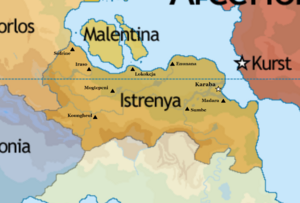
In April of 1959, two Arcer diplomatic officials were out in the large Southern Istrenyan town of Madara, John Francis (Deputy Ambassador) and Nathan Phillips (Head of Development, Istrenya), were having dinner at the Hotel Chekila, an Occidental-owned establishment frequented by members of the Levantine and Southern Cronan elite. Several disenfranchised members of a local farmer's union, frustrated at their protest over tariff increases were frustrated by the police breaking up their strike, and on their walk home encountered Francis and Phillips having dinner on the hotel's outdoor street patio. After a short verbal altercation, Francis and Phillips were violently attacked and beaten, suffering serious injuries that had both in the hospital in critical condition for weeks.
A formal protest was lodged by the Arcer ambassador within twenty four hours, and as a result President Treo cracked down using the Istrenyan National Police. The police broke up multiple union meetings and protests, including several that had the correct permits and permissions. The end result was a massive wave of bad publicity and news articles for the Presidential office, including numerous new protests and open street riots against the police slowly escalating in size and damages to public and private property.
1959 Riots
The 1959 Riots began in earnest by June 1st, with organized peaceful protests in five major towns and cities taking place, primarily along the interior and Western portions of Istrenya. Politically, Eastern Istrenya, which was geographically closer to Arcerion was more friendly and had more Occidental sympathetic, leading to a significant portion of the population disagreeing with the mass protests of the West and central highlands.
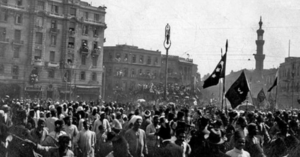
National Police forces clashed violently for several weeks, with dozens of civilians dying a ay in the towns of Iraso and Mogtepeni, both of which were seriously affected by riots and paralyzed by street violence. An organization of unions in Iraso banded together. A collection of farmer's unions, mechanics unions, and foreign members of the Malentine Socialist Party. Self-named, the National Instrenyan People's Front (NIPF) was founded and headed by a former aide to President Treo, Ma'kle Tytosh, who had also previously served as a member of the Istrenyan National Guard. With a lack of weapons equipment, he entreated his foreign socialist and syndicalist counterparts to donate weapons, equipment, and instructors. Camps were set up in the Western Portion of Istrenya, in order to assist with the training of Liberation Battalions. Riots continued in the Eastern half of Istrenya, with the raging street battles destroying pubic transports and public services. Sofrine had both the Town Hall and the National Guard Barracks attacked with fireworks as well as a significant amount of firebombs. Despite heavy losses rom College Students from the nearby Agricultural University, of whom forty died and twice that number were wounded, Sofrine's Populist Government was expelled. Concurrent to the battles raging in Sofrine, the 1st Liberation Battalion left its camp and instigated riots in Iraso, culminating with the Arcer Consulate being attacked. However, members of the Royal Arcerion Constabulary were able to repel the attackers, but transmissions via High-Frequency (HF) radio to the embassy in Karaba made it clear that the riots and civil urnest in the West were becoming a grave danger to Arcer citizens.
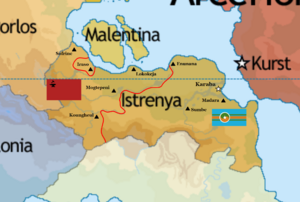
By the fall of 1959, Tytosh's NIPF members, along with local unions, socialist and liberal university students, and foreign fighters began the March to Karaba, a movement politicized and publicized as the means from which they would free Istrenya from foreign corporate and political interference. Starting in late September 1959, Tytosh's forces left Iraso, and quickly overran the National Police garrisons in Mogtopeni by the end of October, with Lokokeha succumbing to the 2nd and 3rd Liberation Battalions a week later. By the first week of December 1959, Enunana had begun to see an increase in labour union activity and it was assessed by members of the Arcerion Foreign Office that Tytosh's forces had begun the process to isolate the city from outside assistance. The incompetence of the National Police Forces and the Istrenyan National Guard meant that Arcerion was rapidly being forced to become involved by New Year's Eve, 1959.
Arcerion's Response
By January 1st, Prime Minister Nathaniel T. MacCallough, one of Arcerion's first post-war Prime Ministers concluded that the situation in Istrenya posed a clear and present danger to the interests of Arcerion and the safety of her citizens. By the end of the first week of January MacCallough had summoned the Arcer Admiralty and the Arcer General Staff to the Confederate Parliament for secret meetings to discuss military options. The conclusion that was a joint task force comprised of an escort carrier group, tactical helicopter squadrons, naval strike aircraft, and two army brigades (7 & 8 Rifle Brigades) with additional clandestine support from the Office of Public Safety and National Security. The initial phase of the war would see members of the Arcerion Commando Regiment (ACR) and Special Arcerion Service Regiment (SASR) would be airdropped into Enunana to delay the Liberation Battalions advance along the coast as part of the March to Karaba. The campaign was set to see the initial deployment begin by March of 1960, and the military quickly ramped up to begin the deployment to secure the Arcer Embassy in Karaba, as well as prepare for the evacuation of the Arcer Consular staff in Iraso.
Operation Insolent
By early March the Joint Task Force, under Major General Timothy McAdams, a veteran of the Second Great War and Operation Lightfoot, had set up their headquarters in Hotel Chekila, the town of Madara. Hundreds of Arcer soldiers were being airlifted in every day, however concerns over the deployment of heavy equipment such as tanks and artillery raised fears and concerns with the Arcer government over the public perception of using such force in what was essentially being sold to the public as a police action and counter-insurgency operation. 7 and 8 Rifle Brigades set up outside Karaba, and prepared for their respective deployments. McAdams moved his tactical headquarters to Karaba to work out of the Arcer Embassy in Karaba, so as to co-locate with the Ambassador and have consistent communication with the Arcer general staff. Once provisional field hospitals, helicopter landing sites, and supply depots had been roughly constructed and were functional, the Army was prepared by the end of March to begin the counter-attacks out towards the West.

During the deployment of the Arcer troops to Eastern Istrenya, A and B Companies from the Arcer Commando Regiment, numbering approximately two hundred men, were inserted via helicopter to Iraso to defend the Arcer embassy. While the perimeter of Iraso was being held by members of the Istrenyan National Guard, Arcer special forces advisors assisted them by directing airstrikes from naval aircraft against NIPF positions. The Commandos would be instrumental for holding the Iraso pocket until eventually relieved by regular Arcer forces. The navy also conducted a considerable amount of strikes in Lokokeja to disrupt the trucks and rail used by NIPF forces to resupply the four Liberation Battalions currently laying siege to Enunana.
McAdams ordered 8 Rifle Brigade, comprised of the Norham Light Infantry and Craigfearn Fusiliers. The six battalions of Arcer infantry conducted a mixture of road marches and used trucks provided by the Istrenyan National Guard, linking up with the beleaguered 2nd Istrenyan Division HQ in Enunana by March 24th. Two weeks of sustained mortar exchanges, use of heavy machineguns in depth, and naval airstrikes helped to break the resolve of Tytosh's Battalions, who slowly began to withdraw, allowing 2nd Battalion from the Norham Light Infantry (2 NLI) to cross the river and cut off many communist forces from withdrawing. With Enunana liberated and allowing the 2nd Istrenyan Division to mop up, 8 Rifle Brigade conducted an advance along the coast for Lokokeja.
Line of Contact
The line of contact along the center of the country roughly created a distinct divide, aside from the Iraso Pocket. In the West, Tytosh's National Instrenyan People's Front (NIPF) Battalions were attempting to establish a new People's Republic of Istrenya. Continued pressure along the Line of Contact meant that from the East the National Guard and supporting Arcerion forces would encroach and liberate more towns and villages as they sought to end the control of the Western portion of the country by subversives.

8 Rifle Brigade continued to drive along the coast towards Lokokeja, fighting running battles with the Liberation Battalions, reaching Lokokeja by mid-summer. Fierce battles on the cities outskirts focused mainly on the suburb of Teremba, a small fishing town with a large wharf that had served as one of the major trucking and ground lines of communication for the retreating NIPF forces as they withdrew to their Western strongholds. In the South, the mountains that flanked the Southern Istrenyan border saw 7 Rifle Brigade conducting company-level offensives with. The Royal Easthampton Borderers (REB), Arcerion Fusilier Regiment (AFR), and the Royal Moorden Regiment (RMR) all participated in actions in the mountains, with fierce battles in the alpine environment resulting in the first large-scale use of helicopters bu the Arcer Army for casualty evacuation (CASEVAC) operations. 7 Rifle Brigade's objective was Mogtopeni, a mountain town with the largest regional airport, which they were aiming to liberate to allow for the infiltration of 11 Parachute Brigade, who had staged in Chester-on-Moore awaiting a cleared drop zone.
Battle of Teremba
Teremba was the key entryway to Lokokeja. Taking the town would allow for use of its wharf, rail junction between the coastal rail line and the mountain rail line, as well as access to Highway 1 - which ran the length of Istrenya to Karaba. The Norham Light Infantry encircled the town, and with fire support from the Craigfearn Fusiliers, managed to seize key objectives by June 17th, even with rebels in the city putting up stiff resistance. Within the town, parts of two Liberation Battalions, including the headquarters from the 1st Battalion, were destroyed due to combined mortar fire and the Combat Controller Section from the Arcer Air Force attached to 2nd Battalion, Norham Light Infantry coordinated with the Royal Arcerion Naval Air Service, coordinating air strikes and close air suppor to the infantry as the conducted the tough job of deliberate clearance in Teremba. Despite a successful seizure of the town, and the now limited ability to Liberation forces to defend Lokokeja, there was a significant amount of damage to the civilian infrastructure, including the local electrical stations which had been destroyed by Arcer mortar fire. Then commander of the Norham Light Infantry, Lieutenant-Colonel Iain Gonnegal remarked on the performance of the Istrenyan National Guard, "..at times we spent more staff hours and effort try to deconflict the armed rabble that we had fighting alongside us, than fighting the communists in the town."

Battle at M'kelo Airport
7 Rifle Brigade after two months of patrolling and fighting with the fifth and sixth Liberation Battalions through the Southern Mountains of Istrenya had arrived at their objective, and began to engage Communist forces at M'kelo Airport, which was the largest civilian air freight airstrip in Istrenya. McAdams was determined to seize it for the Joint Task Force, as the ability to do so would allow them to stage fighters deep within Istrenya, as well as allow for a forward medical facility as 7 Rifle Brigade's deep drive into the Istrenyan foothills had meant evacuating their wounded had become more and more difficult.
The opening engagement saw a significant action by the Royal Easthampton Borderers on the morning of July 22nd, although both 1st and 2nd Battalions were damaged and unable to fully seize their objectives due to a high volume of recoilless rifle and machinegun fire. 3rd Battalion of the Borderers, accompanied by two companies from the Royal Moorden Regiment and utilising a significant number of sorties from the Navy. Combat Controllers from No. 61 Squadron called in sixty-four sorties for close air support, which until then the largest single-day volume of strikes called for by ground forces in a single battle.
After sixteen hours of fighting, around midnight the 5th Liberation Battalion began to withdraw slowly, leaving behind the shattered remains of the 6th Liberation Battalion to screen their retreat. On the morning of July 23rd, 7 Rifle Brigade took the airport in full. A follow-on air assault took place within the next 36 hours, and during the daylight hours on July 24th, 11 Parachute Brigade inserted onto the airfield to assist with the counter-offensive.
Stabilisation and Withdrawal
Ma'kle Tytosh concluded that the war was lost, and fled from his compound near Iraso, to Sofrine, the Northwestern most town in Istrenya. By the fall, 8 Rifle Brigade had fought to the outskirts of Iraso, linking up with 11 Para, who themselves had fought down the length of Highway 3 (Iraso-Mogtepeni) to the South of Iraso. The two brigades conducted the final major offensive action of the war. Fighting for Iraso lasted most of September, and by September 30th elements of the Arcerion Parachute Regiment had reached the Arcer Consulate, relieving the members of the Arcerion Commando Regiment and the consular staff who had been encircled in Iraso for months.
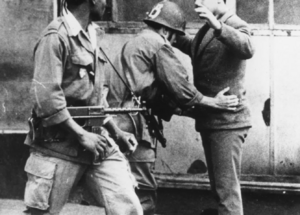
In Sofrine, members of the Intelligence Directorate of the Office of Public Safety and National Security had used human sources they had cultivated within the NIPF, and had been informed that Tytosh was staying at a Plumbing Union's local headquarters. This information was quickly disseminated to the Office's HQ in Kurst, who briefed Prime Minister MacCallough, and with proper authorization the OPSNS inserted a pair of Operations Directorate teams, 'Francoise' and 'Gregory,' with orders to capture Tytosh. After liaising with local Populist sympathizers and former police officers remaining as part of an underground resistance, the teams fought an open gun battle in the streets, eventually leading to Tytosh being killed. Istrenyan National Policemen paraded the corpse through the streets, eventually nailing it to a lamppost in the town square in central Sofrine. With their leader killed and Arcer soldiers and their National Guard counterparts closing on all fronts, the remaining NIPF forces collapsed, with 8 Rifle Brigade securing Sofrine in its entirety by the last week of November. The mountain stronghold of Koungheul was the final NIPF area to surrender, with the commanding officer of 7 Rifle Brigade and the commander of the 3rd Istrenyan Division jointly accepting the formal capitulation of the 5th Liberation Battalion on December 11th, 1960. With the situation now stabilised, the remainder of the year was spent assisting the OPSNS and SASR as they looked to arrest the remaining political dissidents that had subverted the existing government's rule. President A'kale Treo, despite formal protests against continued economic sanctions from Arcerion against Istrenyan agriculture, permitted the continued actions of the Arcer Armed Forces as they quelled further unrest. Specific attention was paid to Malentine and Porlosi foreign fighters and ensuring they were handed over to Istrenyan authorities. The Istrenyan National Guard consolidated their few divisions and attempted to reconstitute, with both 11 Parachute Brigade and 7 Rifle Brigade being withdrawn to Arcerion, leaving only 8 Rifle as a stabilisation force. The remaining Arcer troops assisted the reconstruction of the National Police Forces, and utilised helicopters to move individual companies around Istrenya throughout 1961 to put down smaller riots and uprisings to prevent another surge of violence. As of fall 1961, the Arcer Armed Forces began a full withdrawal from Istrenya, leaving the country to the Presidential Office and Security Forces.
Arcer Embassy Closure
With the fallout of the scandal being sustained assaults against Arcer citizens and diplomatic infrastructure, the Foreign Office of Arcerion formally withdrew its embassy and permant staff from Istrenya in 1961, including the closure of the consulate in Iraso. Prime Minister MacCallough commented publicly in the Kinnaird Financial Times that Arcerion's engagement in the Southwestern Cronan Peninsula was no longer to be centered around Istrenya and ties with their government, but instead would shift to a larger whole-of-peninsula approach that would see an increase in Porlosi diplomatic overtures.
OPSNS Involvement
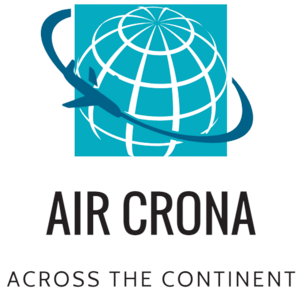
While the Arcer government has rarely commented on the official nature of the Office of Public Safety and National Security or its missions, several news articles, books, and undisclosed interviews with former employees during the 1980s and 1990s highlighted the extensive role of the OPSNS in Istrenya. The OPSNS would use its secretive and privately-owned airline, Air Crona, to insert members of the Special Arcer Service Regiment, as well as its own Intelligence and Operations Directorate operatives. Air Crona and the OPSNS also conducted secretive resupply missions to the Istrenyan resistance West of the Line of Contact, providing weapons, equipment, and training to combat and tie down NIPF forces. The OPSNS also was alleged to have undertaken a series of assassinations, car bombings, acts of arson, and other clandestine missions to degrade the NIPF's ability to fight. OPSNS involvement culminated in the death of Ma'kle Tytosh, who was shot to death at his new headquarters in Sofrine, Istrenya.
It has been alleged in several newer sources of media that the two politicians that were attacked, John Francis and Nathan Phillips, were actually OPSNS Intelligence Officers working in Istrenya and they were attacked by the Istrenyan National Police Forces, who used the communist and socialist riots as a cover-up to hide their activities intimidating Arcer influence in Istrenya. The Istrenyan government and the Arcer Foreign Ministry have both openly decried and declared such allegations outlandish and false.
Aftermath and Legacy
Istrenya would continue to be a relatively poor economic and Indigenous nation in South Crona. Continued economic sanctions from Arcerion, relatively weak and unstable currency, as well as continued instability crippled its growth and development until the 1990s and Arcerion re-establishing a diplomatic presence with a consulate in Karaba. Arcerion's long term public opinion of the conflict was of a necessary police action to suppress communists that were a short ferry ride away from one of Arcerion's largest cities. Many regiments and squadrons in the Arcer Military still remember the conflict as the first major action after the Second Great War, with the Royal Moorden Regiment still celebrating July 23rd as the anniversary of the victory at M'kelo Airport. The Norham Light Infantry have named their main garrison in Arcerion the 'Teremba Barracks' after their engagement in Istrenya. In Istrenya, the conflict is more commonly remembered as a civil war, with Ma'kle Tytosh being one of the few individuals from that period still considered a national person of significance despite attempts by the Populist Government to destroy any national memory to prevent another uprising.